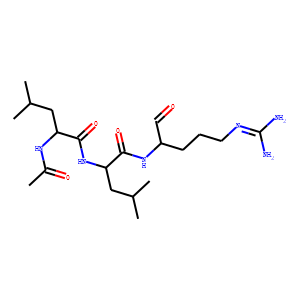| Reference | 1. J Mol Biol. 2006 Mar 17;357(1):195-209. Epub 2005 Dec 28.
<br>
X-ray structures of free and leupeptin-complexed human alphaI-tryptase mutants:
indication for an alpha–>beta-tryptase transition.
<br>
Rohr KB(1), Selwood T, Marquardt U, Huber R, Schechter NM, Bode W, Than ME.
<br>
Author information: <br>
(1)Max-Planck-Institut für Biochemie, Abteilung Strukturforschung, Am
Klopferspitz 18, 82152 Martinsried, Germany.
<br>
Tryptases alpha and beta are trypsin-like serine proteinases expressed in large
amounts by mast cells. Beta-tryptase is a tetramer that has enzymatic activity,
but requires heparin binding to maintain functional and structural stability,
whereas alpha-tryptase has little, if any, enzymatic activity but is a stable
tetramer in the absence of heparin. As shown previously, these differences can be
mainly attributed to the different conformations of the 214-220 segment.
Interestingly, the replacement of Asp216 by Gly, which is present in
beta-tryptase, results in enzymatically active but less stable alpha-tryptase
mutants. We have solved the crystal structures of both the single (D216G) and the
double (K192Q/D216G) mutant forms of recombinant human alphaI-tryptase in complex
with the peptide inhibitor leupeptin, as well as the structure of the
non-inhibited single mutant. The inhibited mutants exhibited an open functional
substrate binding site, while in the absence of an inhibitor, the open
(beta-tryptase-like) and the closed (alpha-tryptase-like) conformations were
present simultaneously. This shows that both forms are in a two-state
equilibrium, which is influenced by the residues in the vicinity of the active
site and by inhibitor/substrate binding. Novel insights regarding the observed
stability differences as well as a potential proteolytic activity of wild-type
alpha-tryptase, which may possess a cryptic active site, are discussed.
<br>
2. Med Sci Monit. 2004 Jan;10(1):BR4-10.
<br>
Protease inhibitor leupeptin attenuates myocardial stunning in rat heart.
<br>
Rudziński T(1), Mussur M, Gwiazda Z, Mussur M.
<br>
Author information: <br>
(1)Department of Cardiosurgery, Institute of Cardiology, Medical University of
Łodź, Poland.
<br>
BACKGROUND: In order to test the hypothesis that cardiac protein degradation
contributes to the pathogenesis of myocardial stunning, the effect of protease
inhibitor leupeptin on the postischemic hemodynamics and metabolic functioning
was measured in isolated rat hearts.<br>
MATERIAL/METHODS: Isolated rat hearts were perfused in Langendorff mode in the
presence or absence of leupeptin (10 Kg/ml for 10 min.), and then subjected to 20
min. of normothermic ischemia and 30 min. of reperfusion. Aortic pressure,
cardiac output, coronary flow (CF), global oxygen consumption (MVO2), carbon
dioxide and [H+] release, and [Ca2+] uptake were investigated.
RESULTS: Hearts pretreated with leupeptin exhibited better postischemic return of
systolic, diastolic and developed aortic pressure and faster return of CF to
preischemic values during reperfusion. MVO2 and CO2 release were lower in this
group in the 10th and 15th min. of reperfusion and [Ca2+] uptake higher in the
5th and 15th min. of reperfusion<br>
CONCLUSIONS: Leupeptin protects the heart from myocardial stunning, which is
consistent with the idea that proteases contribute to the pathogenesis of this
phenomenon.
<br>
3. Neuroscience. 2004;125(2):427-39.
<br>
Inhibition of calpains, by treatment with leupeptin, improves motoneuron survival
and muscle function in models of motoneuron degeneration.
<br>
Kieran D(1), Greensmith L.
<br>
Author information: <br>
(1)The Graham Watts Laboratories, Sobell Department of Motor Neuroscience and
Movement Disorders, Institute of Neurology, University College London, Queen
Square, London WC1N 3BG, UK.
<br>
The effect of treatment with leupeptin, a calpain inhibitor, on motoneuron
survival and muscle function was examined in in vitro and in vivo models of
motoneuron degeneration. Exposure of primary rat motoneurons to
alpha-amino-3-hydroxy-5-methyl-4-isoxazole-propionic acid (AMPA) is an
established in vitro model of excitotoxic motoneuron death. Here we show that
leupeptin treatment improved motoneuron survival following exposure to AMPA (50
microM). Application of leupeptin (100 microM) to AMPA treated cultures rescued
many motoneurons so that 74% (+/-3.4 S.E.M., n=5) survived compared with only 49%
(+/-2.4 S.E.M., n=5) in untreated cultures. The effect of treatment with
leupeptin on motoneuron survival and muscle function was also examined in vivo.
In 3 day-old rats, the sciatic nerve was crushed and at the time of injury, a
silicon implant containing leupeptin was inserted onto the lumbar spinal cord.
The effect on long-term motoneuron survival and muscle function was assessed 12
weeks after injury. The results showed that there was long-term improvement in
motoneuron survival in the leupeptin treated group. Thus, in untreated animals 12
weeks after nerve crush only 30% (+/-2.8. S.E.M., n=3) of sciatic motoneurons
survived compared with 43% (+/-1.5 S.E.M., n=3) in the leupeptin-treated group.
This improvement in motoneuron survival was reflected in a significant
improvement in muscle function in the leupeptin-treated group. For example in the
soleus muscle of treated rats 20.8 (+/-1.40 S.E.M., n=5) motor units survived
compared with only 14.6 (+/-1.21 S.E.M., n=5) in untreated animals. Thus,
treatment with leupeptin, a calpain inhibitor, rescues motoneurons from cell
death and improves muscle function following nerve injury.
<br>
|

